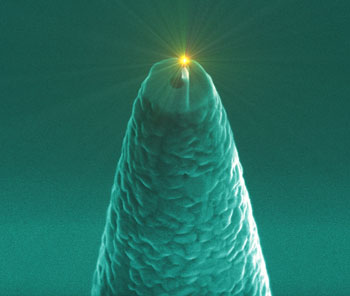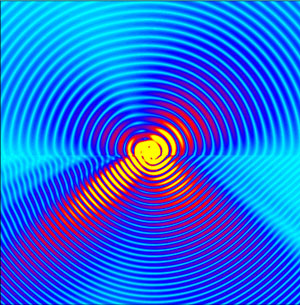| Posted: Mar 27, 2008 | |
Nano-antennas light up molecules |
|
| (Nanowerk Spotlight) A key challenge in nano-optics is to bring light to and collect light from nano-scale systems. In conventional electronics, the interconnect between locally stored and radiated signals, for example radio broadcasts, is formed by antennas. For an antenna to work at the wavelength of light it needs to be greatly scaled down, to the nanoscale. | |
| Antennas play a key role in our modern wireless society. The electromagnetic waves sent and received by antennas are the messages that enable communication between electronics. Antennas with a wide variety of sizes make it possible for us receive radio broadcasts, watch television and talk to others on a mobile phone. For an effective communication, the antenna needs to direct signals towards their intended target and, vice versa, collect signals from a desired source. | |
| Now, researchers have shown that the concept of an antenna is equally well applied to direct the visible light sent out by a single molecule. For an antenna to work with visible light, it needs to be millions of times smaller than a conventional antenna. In this case, it is only 80 nanometer long. By placing the antenna near an individual molecule the light from that molecule is re-directed; the molecular message can be steered to a desired target, making efficient communication possible. | |
| These novel nano-antennas have important implications. In (bio)sensing, light can be sent to a molecule and, in turn, its response aimed to a detector. Furthermore, the antennas can be part of efficient nano-sized light sources. Finally, it is interesting to see that the antenna designs that revolutionized communication keep finding new applications, this time at the nanometer scale. | |
 |
|
| Artist's impression of a molecule lighting up close to a nano-antenna (Image: T. H. Taminiau) | |
| "We have shown that a metal nano-particle functions as an optical antenna for a single molecule" Dr. Niek van Hulst tells Nanowerk. "We demonstrated that the light emitted by a molecule is directed by an optical monopole antenna, just as radio waves are directed by a radio antenna. The direction in which the light is emitted depends on the antenna design, not on the molecule." | |
| Van Hulst, a professor at the Institute of Photonic Sciences (ICFO) in Barcelona, Spain, explains that there are two ways in which this advances the field of nano-optics: by increasing the understanding of optical antennas and by experimentally demonstrating them. | |
| "First, by studying the most elementary system, an individual molecule coupled to a simple monopole antenna, we reveal how an optical antenna works. The resulting direction of emission was not anticipated and will change the interpretation of previous and future experiments. | |
| "Second, the experimental demonstration serves as a proof of principle and gives a clear guideline how to proceed and implement the large available library of (radio) antennas for applications in nano-optics." | |
| Tim Taminiau, a PhD student in van Hulst's group, and first author of a recent paper in Nature Photonics describing these optical nano-antennas ("Optical antennas direct single-molecule emission") remarks that the concept of an antenna and directing emission has of course been known for over a century. | |
| "But our demonstration on the nano-scale with visible light coming from molecules is a first" he says. "It is the first experiment where a single molecule is brought near a well-defined optical antenna and the effects on the direction of molecular emission are studied. There are several differences between working with visible light compared to radio frequencies. For example, metals behave different at optical frequencies and this has to be taken into account into the antenna design. The experimental demonstration presented here shows that despite the differences the same ideas can be applied in nano-optics as in antenna theory." | |
 |
|
| The calculated emission of a molecule coupled to a dipole antenna (Image: T. H. Taminiau) | |
| Taminiau explains that the original motivation of the research team might seem unrelated at first: " We set out to build a better microscope" he says. "By building an optical antenna for a single molecule, one can communicate efficiently with that molecule. The antenna can be moved around; we can select the molecule we communicate with. Since the antenna is so small, we can do this with very high precision. The antenna thus acts like a high resolution microscope (resolution of around 20 nm, the antenna radius). However to use the antenna in this way, it first is crucial to understand how it works!" | |
| In a previous paper in Nano Letters the researchers already discussed some other details of the antenna and its functioning as a microscope ("λ/4 Resonance of an Optical Monopole Antenna Probed by Single Molecule Fluorescence"). | |
| Optical antennas can be used to efficiently send light to and receive light from nano-sized systems. Van Hulst points out that in a sensor, one can use optical antennas to bring light to a small active area and direct the response obtained towards detector. "Antennas could be used to create efficient and directed nano-optical light sources" he says. "When the antenna position can be varied they can be used in high resolution (sub-diffraction limited) optical microscopes." | |
| This work now opens several avenues of exploration. Since antennas can interact with single molecules, it will be interesting to see the connections and applications of optical antennas in quantum optics and quantum information. Taminiau points out that especially the ability of an antenna to enhance the interaction of a molecule – or atom, ion or quantum dot – with light is an interesting prospect for quantum optics. | |
| "Having demonstrated an elementary antenna, it will be interesting to now move on to incorporate more complicated and specific antennas into nano-optics" says van Hulst. "One can think of narrowband cavity antennas or highly directive Yagi-Uda antennas (TV-antenna) on the nano-scale. For now, it is interesting to see how old concepts lead to novel tools on the nano-scale." | |
 By
Michael
Berger
– Michael is author of three books by the Royal Society of Chemistry:
Nano-Society: Pushing the Boundaries of Technology,
Nanotechnology: The Future is Tiny, and
Nanoengineering: The Skills and Tools Making Technology Invisible
Copyright ©
Nanowerk LLC
By
Michael
Berger
– Michael is author of three books by the Royal Society of Chemistry:
Nano-Society: Pushing the Boundaries of Technology,
Nanotechnology: The Future is Tiny, and
Nanoengineering: The Skills and Tools Making Technology Invisible
Copyright ©
Nanowerk LLC
|
Become a Spotlight guest author! Join our large and growing group of guest contributors. Have you just published a scientific paper or have other exciting developments to share with the nanotechnology community? Here is how to publish on nanowerk.com.
